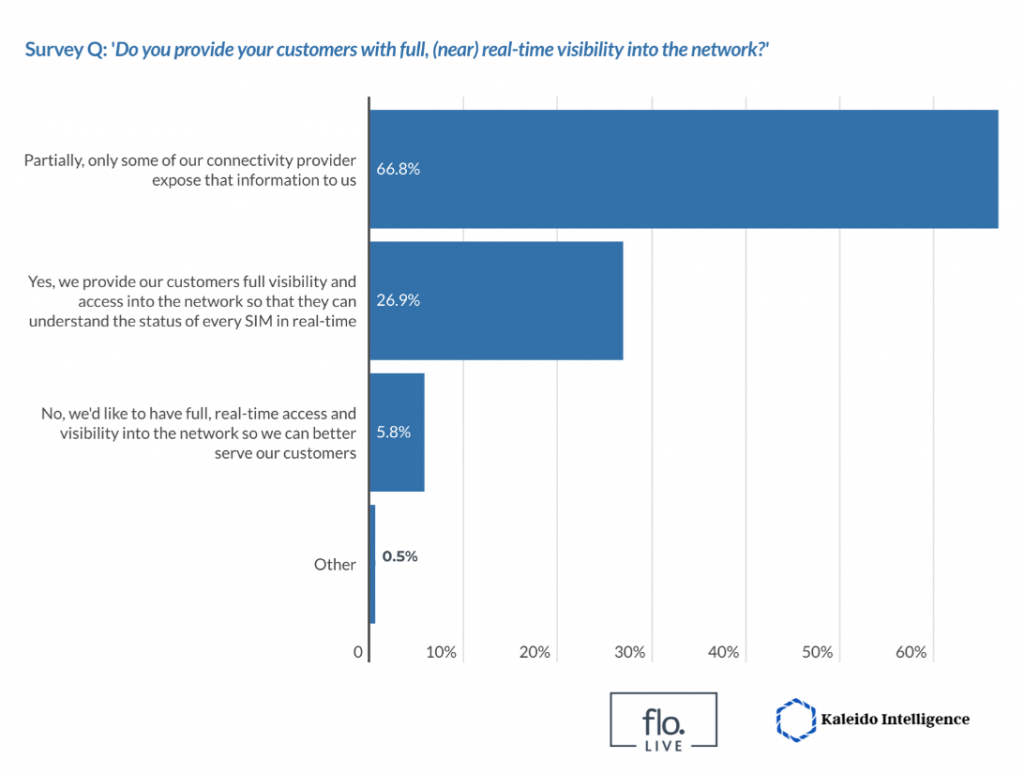floLIVE, creator of the world’s first and largest global cellular infrastructure and a leading provider of global connectivity and network services for IoT, is releasing the results of a global survey of IoT connectivity providers conducted by leading analyst firm Kaleido Intelligence. Over two-thirds (72%) of respondents stated that they do not have full visibility into network activity.
The survey, sponsored by floLIVE, gauged the state of IoT connectivity as told through the lens of Mobile Virtual Network Operators (MVNOs) and IoT Service Providers (IoT SPs) who deliver connectivity solutions to IoT customers worldwide.

Real-time Visibility Crucial to Meet Today’s IoT Demands
According to the survey, only 27 percent of respondents provide customers with full visibility and network access. Such a technical capability is a critical factor in enhancing service quality – understanding devices’ behaviour and whether they are connecting to the network as expected is a critical quality that today’s increasingly sophisticated IoT customer base expects.
Additionally, gaps in visibility create security risks and can lead to cost overruns if device anomalies are not detected in real-time. Troubleshooting and incident resolution can take much longer and require cumbersome processes.
The core network forms the basis for providing real-time network visibility and insights; modern, IoT-focused core networks are purpose-built to expose deep network insights to customers to understand their behaviour better, run analytics, and identify abnormal behaviour, security breaches or fraud attempts so that these can be treated quickly and effectively.
Many MVNOs and IoT SPs rely on Mobile Network Operator (MNO) infrastructure – the MNO core network, connectivity management platform (CMP), as well as Business Support Systems (BSS) and Operations Support Systems (OSS) – to deliver connectivity. However, these systems have largely been designed to support consumer use cases and not IoT, and in many cases, are inadequate for large-scale IoT deployments, both from a technical and commercial standpoint.
The Takeaway: floLIVE & Kaleido Viewpoints
Kaleido’s survey was participated in by over 200 MVNOs and IoT Service Providers. Findings in the report assess key findings, also aligning with the wider connectivity needs as seen by enterprises cellular IoT connectivity strategies and CMP requirements.
“Gone are the ‘Wild West’ days of IoT where you deployed devices into the fleet and hoped for the best,” floLIVE CEO Nir Shalom said. “CMPs have become table stakes for IoT customers, yet delivering a solution that can meet the complex demands of the customer has been a historical challenge. We are excited to be able to give our MVNO and ISP customers a platform that is simple to deploy, yet powerful to meet those complex demands and give visibility into SIMs, whether it’s 100 or 100,000.”
The desire for a holistic, carrier-agnostic CMP to better understand device behaviour and support IoT security is evidenced in the survey responses.
“IoT has reached a significant turning point where increasingly complex and larger device deployments require best-in-class solutions to support connectivity,” Kaleido Intelligence Chief of Research Steffen Sorrell noted. “MVNOs and IoT SPs providing connectivity to customers form a crucial part of the market and their customers need to be supported through a CMP that allows customers full access and control over their device fleets.”
Comment on this article below or via X: @IoTNow_
